Calathea lancifolia, also known as Calathea Rattlesnake, is a Calathea cultivar that produces wavy leaves in hues of bright green. These leaves are stripped with dark green ovals that alternate.
Like some of the other Calathea varieties, the underside of the Calathea rattlesnake leaves have a purplish maroon color. It’s these unique markings that resemble a rattlesnake’s tail that the plant is named after.
The Calathea rattlesnake is native to tropical Brazil and, like other tropical houseplants, does require a certain level of care that can be considered a bit more difficult than other plants. That doesn’t mean, however, that you shouldn’t try to grow this stunning plant!
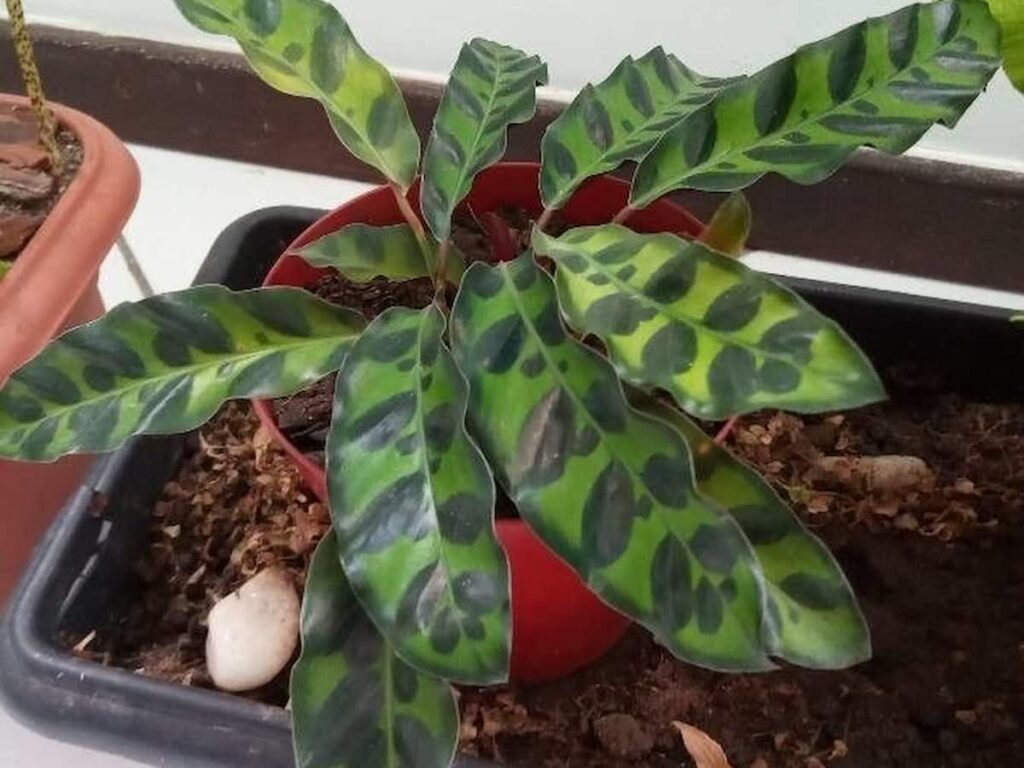
Table of Contents
Calathea rattlesnake vs calathea lancifolia
Despite the two different names, Calathea rattlesnake and Calathea Lancifolia are the same plant. This plant is also known as the Rattlesnake plant. Calathea Lancifolia is the previous scientific name for this plant, but its common name is Rattlesnake plant or Calathea rattlesnake.
While it may seem odd that a plant goes by multiple names, it is actually quite common in the plant world. In fact, most plants have various monikers that can even vary from one region to the next.
To make things even more complicated, Calathea Lancifolia is the old scientific name for this plant. This plant was recently reclassified to Goeppertia insignis.
How to care for calathea rattlesnake
The best way to care for the Calathea rattlesnake is to ensure it receives bright, indirect light for at least 6 hours a day, create a humid environment, fertilizer the plant once a month when it’s actively growing, keep the soil moist but not soggy, and maintain temperatures between 65 and 80 degrees.
Calathea rattlesnakes are not too difficult to care for, but they do need a bit more attending to than some other houseplants. This is a wonderful option for anyone who wants to challenge themselves a bit without going full force with a temperamental plant.
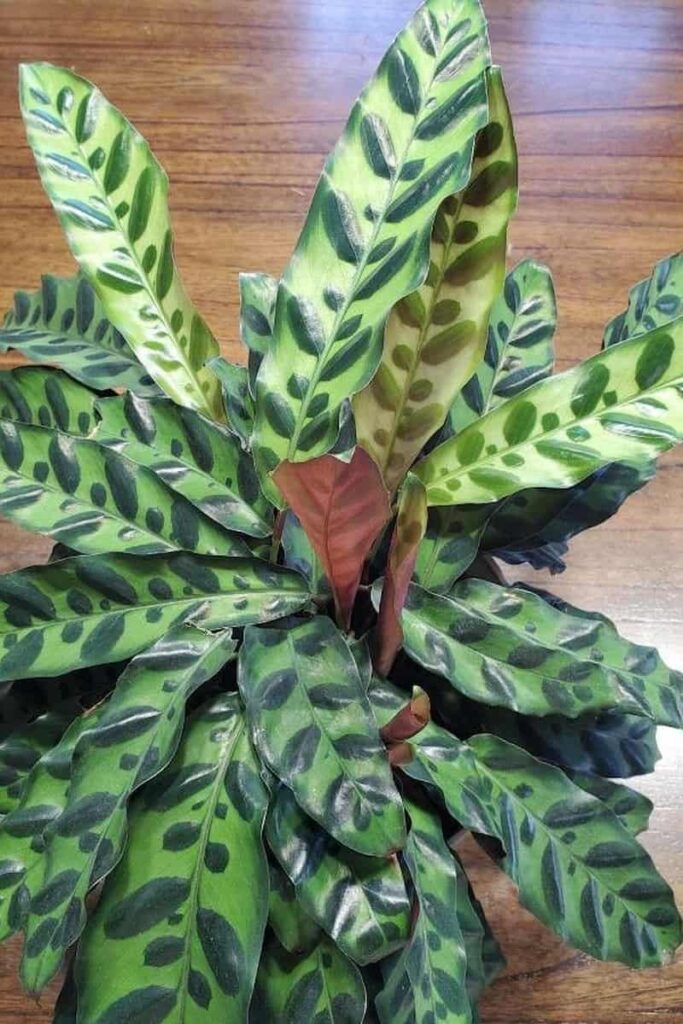
How much sun does a rattlesnake calathea need?
Calathea rattlesnake needs 6 to 10 hours of indirect sun. Bright light is the best option, but this plant can also grow in medium light. While the Calathea rattlesnake can be placed in some low light conditions, a well lit room out of direct sun is the best option for this plant.
The best indoor location for the Calathea rattlesnake is near a north-facing window. East- and west-facing windows will also work for this tropical plant, as long as you keep it out of direct sunlight.
Covering the window with a sheer curtain or blind helps to protect the plant from any harsh sun rays that may shine through.
Exposing the Calathea rattlesnake to direct sunlight can leave its foliage scorched, burned, and discolored. It will also dry the plant out quicker and can even stunt its growth.
Related: Calathea Light Requirements: The Ultimate Guide
How often should I water a calathea lancifolia?
Calathea Lancifolia is a plant that thrives when its soil is moist but not waterlogged. In general, this plant will need water once every week or two. However, you should always check the soil before watering and only water when the top inch of soil feels dry.
Keep in mind that the exact time frame varies from one situation to the next, and you shouldn’t just assume the plant needs water without checking the dryness of its soil.
The age and size of the Calathea Lancifolia, as well as the time of year and environmental conditions can all affect how often the calathea plant is watered.
Because of this, when you do water the Calathea Lancifolia, consider utilizing the bottom watering technique which will help to prevent drowning the plant in its pot. Additionally, only use distilled water and never tap water, since Calatheas are sensitive to tap water.
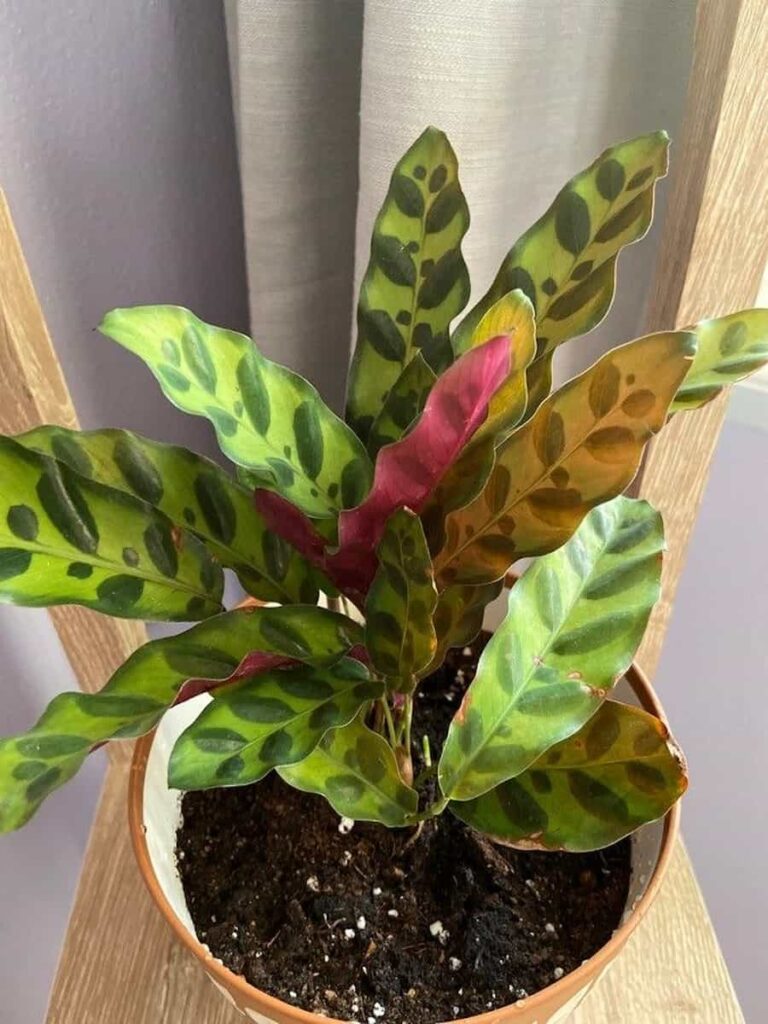
What’s the best soil for calathea rattlesnake?
Calathea rattlesnake needs soil that drains well while still having a moderate ability to retain water. The ideal mixture for this plant is 50 percent perlite and 50 percent peat moss with a little worm compost mixed in. This mixture is light, airy and drains well, while also retaining a little moisture.
The added worm compost increases the micro-nutrient content of the soil mixture. This is an important part of indoor gardening that is often overlooked. Just like your outdoor plants, houseplants need their soil amended every so often to help replenish nutrients.
Regular compost can be used as a substitute for worm compost, and can be reapplied once every 6 months as needed.
Related: Best Calathea Soil: Tips to Pick the Right Potting Mix
What are the ideal calathea rattlesnake humidity levels?
Calathea rattlesnake is native to a tropical region that has a naturally high humidity level. That doesn’t mean that this humidity level should be ignored just because the plant is grown indoors. In fact, it is vital that the Calathea rattlesnake gets a humidity level of at least 50 percent.
Humidifers and drip trays work well to help increase the humidity level around the Calathea rattlesnake. Both are readily available at stores both online and off, and are relatively inexpensive. Another option is to mist the leaves of the Calathea rattlesnake whenever conditions are dry.
To make your own drip tray, fill a shallow tray with small pebbles and then set the Calathea rattlesnake on top of the tray. Whenever you water the plant, the excess water will drain out of the pot and into the tray. This water will then naturally evaporate and increase the humidity level around the plant.
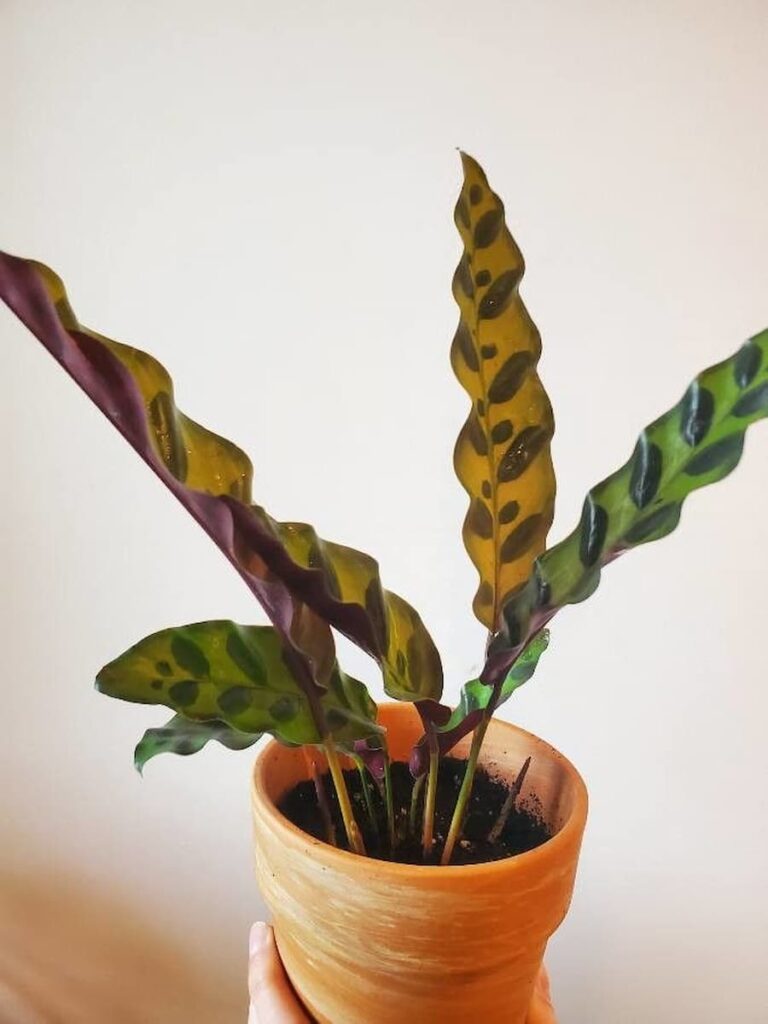
What’s the best fertilizer for calathea rattlesnake?
Calathea rattlesnakes are not heavy feeders, but you should still apply a liquid fertilizer designed for tropical houseplants that also contains iron. Fertilize the plant once a month during the spring and summer, which is when the plant is actively growing.
To help prevent damage caused by overfertilizing the Calathea Lancifolia, dilute your calathea’s fertilizer to half of its strength. Additionally, familiarize yourself with the directions and warnings on the fertilizer label, and never use fertilizer that is out of date or considered low quality.
Since overfeeding is a real threat, watch for any signs of overfertilization and immediately stop all feeding if any signs appear. An overfed Calathea rattlesnake will need to have its soil flushed in order to remove the buildup of salts and minerals.
Are calathea rattlesnake plants easy to care for?
Calatheas are often thought of as a fussy plant, but the Calathea rattlesnake is considered the easiest of all the Calathea cultivars. This plant can grow in various lighting conditions, from bright to low light, and doesn’t require as high of a humidity level as other Calatheas.
Novice indoor gardeners who are looking to grow a Calathea plant may want to consider the Calathea rattlesnake instead of another variety. This can help make you a bit more comfortable with growing difficult plants.
Once you have learned the needs of the Calathea rattlesnake and feel confident in your ability to care for it, you can add one of the harder Calathea varieties, such as Calathea White Fusion, to your indoor garden.
How big does calathea lancifolia get?
The mature height of the Calathea Lancifolia is about 30 inches, though this can vary depending on how well it is cared for. The Calathea rattlesnake has a medium growth rate, so don’t expect the plant to quickly grow a few inches every year.
Additionally, the plant’s growth rate becomes even slower if you have it growing in low lighting conditions.
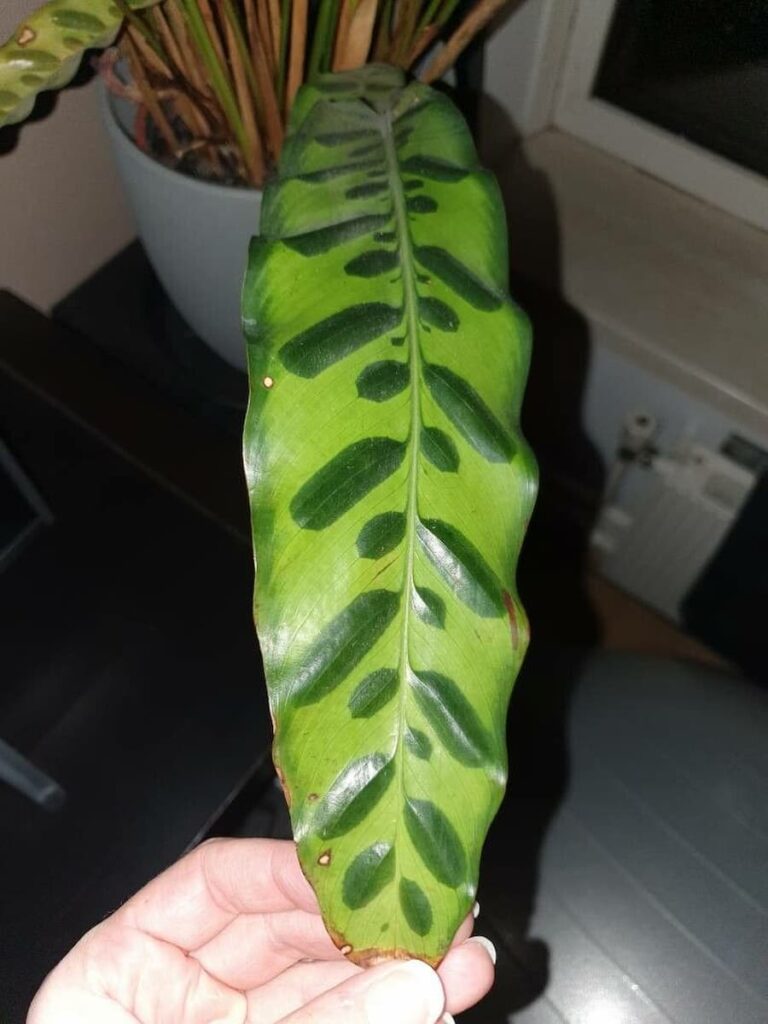
Remember that an unhealthy Calathea Lancifolia grows slower than a healthy one. If you want your Calathea to grow as quickly as possible, make sure you keep your plant healthy and happy. This will require providing the plant with its ideal growing conditions.
Furthermore, an unhealthy Calathea rattlesnake plant is more likely to experience pest and disease problems, like spider mites on calathea, both of which can take their toll on the growth rate of the plant. Keeping an eye out for potential problems and acting quickly when one arises goes a long way to maintaining the plant’s health while also encouraging growth.
Is calathea lancifolia a prayer plant?
Calatheas are also known as prayer plants, and the Calathea Lancifolia is no exception. At night, when the light is low, the Calathea’s leaves will close up to help conserve energy. In the day, the leaves will open and even move towards the light.
This is a natural occurrence with prayer plants and a sign that the plant is healthy.
Is rattlesnake calathea poisonous?
Rattlesnake Calathea is not poisonous and can be safely grown in homes with children and pets. Just because it’s non toxic doesn’t mean you should let children and pets eat the plant. Consuming the Rattlesnake Calathea can still cause an upset stomach, which is not a pleasant experience.
Additionally, allowing children and pets to eat the Rattlesnake Calathea damages the plant itself and can even decrease the overall health of the Calathea. To keep the plant safe, make sure to place it out of children and pets’ reach.
Related: Is Calathea Toxic to Cats, Dogs or Humans?
Why are my calathea lancifolia’s leaves curling?
When your Calathea Lancifolia‘s leaves are curling, the plant is more than likely not receiving the proper amount of water. Underwatering will dry your plant out, turn its leaves brown and crispy. If the underwatering continues, the plant will wilt, leaves will drop, and its growth suffers.
The easiest way to determine if underwatering is your problem is to simply look at the Calathea rattlesnake’s soil. If it feels dry and is pulling away from the sides of the pot, you know the plant is not getting enough water. Thankfully, this is a relatively easy problem to fix.
Simply soak the bottom of the Calathea Lancifolia’s pot in water for about 20 to 30 minutes. Once the soil feels moist, remove the plant from the water. Make sure to check the soil every few days and water when the top inch of soil feels dry.
You may also be interested in: 6 Causes of Your Calathea Leaves Curling (+ How to Fix It)
Why are my calathea rattlesnake’s leaves turning yellow?
Overwatering is a serious problem that can be fatal to your Calathea rattlesnake, and yellowing leaves are one of the most common symptoms of this issue. Overwatered plants have soggy soils, which interfere with the plant’s ability to absorb nutrients. This will cause the leaves to yellow, wilt, and fall off the plant.
If the overwatering is not fixed, the plant will develop root rot, which is a serious and potentially deadly disease.
There is no cure for root rot and trying to save a plant infected with the disease is nearly impossible. The only good thing about overwatering is that it is completely preventable.
You can quickly confirm that overwatering is the cause of the yellowing calathea leaves by simply looking at the soil. Soggy soils are the number one giveaway that a plant has been overwatered.
If the soil is soggy, immediately stop watering the Calathea and don’t start watering again until the top inch of soil is dry.
